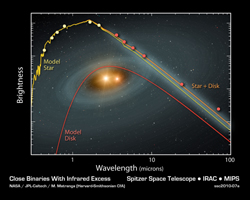
Close Binaries with Infrared Excess
Click on the image for the larger version
This artist's concept illustrates a tight pair of stars and a surrounding disk of dust -- most likely the shattered remains of planetary smashups. Using NASA's Spitzer Space Telescope, the scientists found dusty evidence for such collisions around three sets of stellar twins (a class of stars called RS Canum Venaticorum's or RS CVns for short). The stars, which are similar to our sun in mass and age, orbit very closely around each other. They are separated by just two percent of the Earth-sun distance. With time, they get closer and closer, until the gravitational harmony in the system is thrown out of whack. Planetary bodies -- planets, asteroids and comets -- are thought to migrate out of their stable orbits, and smash together.
Spitzer's cameras, which take pictures at different infrared wavelengths, observed the signatures of dust around three close binary systems. Data for one of those systems (Figure 1) are shown in orange. Models for the stars and a surrounding dusty disk are shown in yellow and red, respectively. The disk reveals that some sort of chaotic event -- probably a planetary collision -- must have generated the dusty disk.

